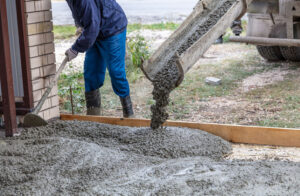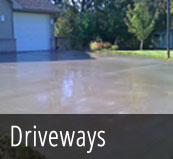
Concrete is one of the most durable materials out there, which is why it’s so commonly used in driveways, patios, sidewalks, and even countertops. But over time, even the toughest concrete can crack, stain, or show signs of wear that affect both its appearance and its function. If you’re noticing significant damage to your concrete surfaces, it might be time for a full replacement. But before you grab a sledgehammer and start tearing things up, there are a few things you should know.
Here’s a breakdown of the process, the challenges you might face, and how long it all takes.
Why Replace Old Concrete?
Before diving into the nuts and bolts of the replacement process, it’s important to understand why replacing your old concrete is such a good idea.
- Improved Safety: Cracks and uneven surfaces can create tripping hazards, especially on driveways or walkways. Replacing your concrete reduces the risk of accidents.
- Enhanced Curb Appeal: Old, cracked, or stained concrete can drag down your home’s overall appearance. A new concrete surface can boost the aesthetic appeal of your property, making it look fresh and well-maintained.
- Long-Term Durability: Old concrete can deteriorate over time, especially if it’s exposed to the elements. New concrete is not only more visually appealing but also more reliable for years to come.
- Increased Property Value: Whether you’re planning to sell or not, replacing concrete surfaces is an investment that adds value to your home. Buyers will appreciate seeing that key areas like driveways or patios have been recently updated.
The Process of Replacing Concrete
Now that you understand why it’s worth replacing old concrete, let’s dive into the actual process of tearing it out and installing new concrete. Here’s what you can expect:
1. Consultation and Assessment
The first step is always consultation. A professional concrete contractor will visit your property to assess the current condition of your concrete. They’ll determine if replacement is necessary or if a repair will suffice. If replacement is the best option, they’ll walk you through the next steps.
2. Planning and Preparation
Once you’ve decided to move forward, the next phase is planning. This involves selecting the type of concrete that works best for your needs. Whether you want a traditional finish, something decorative like stamped concrete, or maybe concrete countertops, this is the time to decide. Your contractor will measure the area and ensure the design matches your vision.
3. Tearing Out the Old Concrete
Here’s where the real work begins. The first step in the teardown is breaking up the existing concrete. Professional contractors use tools like jackhammers, skid loaders, or concrete saws to break the concrete into smaller, manageable pieces. The debris is then carefully removed, and the area is cleared, ready for the new pour.
4. Preparing the Subbase
The subbase (the soil and gravel beneath the concrete) is a critical part of the process. Your contractor will inspect it for any issues and may need to compact it or add additional materials like gravel. This ensures a strong foundation for the new concrete.
5. Pouring the New Concrete
Once the subbase is ready, it’s time to pour the new concrete. Fresh concrete is mixed and poured into the prepared space, whether it’s for a driveway, patio, or countertop. The concrete is leveled and smoothed to achieve the desired finish. If you’re opting for a decorative style, like stamped or colored concrete, this is when the design elements are added.
6. Finishing Touches
Once the concrete is poured, it’s time for finishing. Your contractor will smooth the surface, ensuring it is level and aesthetically pleasing. For decorative concrete, textures and patterns are added at this stage. After finishing, the concrete needs time to set, so it can be left undisturbed for proper curing.
7. Curing and Sealing
The curing process is vital to the strength and longevity of your concrete. While it may seem ready to use after a day or two, concrete can take up to a week to fully cure. During this time, it’s important to avoid heavy traffic on the surface. After curing, a sealer is applied to protect the concrete from stains, moisture, and other elements. This is the final touch that ensures your new concrete will last for years.
Challenges to Be Aware Of
As with any major home improvement project, replacing concrete can present a few challenges. Here’s what to keep in mind:
- Cost: Replacing concrete can be pricey, especially if you’re working with large areas. Factors like the complexity of the job and the materials chosen will impact the final price.
- Mess and Disruption: Concrete removal is a messy job, and there will be some disruption to your daily routine. Expect noise, dust, and debris, especially during the demolition phase.
- Weather Delays: Concrete work is heavily dependent on weather conditions. Rain or extreme temperatures can delay the project, so it’s important to plan for possible weather setbacks.
- Permit Requirements: Depending on where you live, you might need a permit for concrete replacement, especially for driveways or patios. Be sure to consult with your contractor to ensure that all necessary permits are in place.
Timeline Expectations
The timeline for tearing out and replacing concrete varies based on the size of the project, the complexity of the design, and the weather. On average, the entire process can take anywhere from 3 to 7 days:
- Assessment and planning: 1-2 days
- Concrete tear-out: 1-2 days
- Subbase preparation: 1 day
- Pouring and finishing the new concrete: 1 day
- Curing and sealing: 3-5 days (curing), 1 day (sealing)
For a full replacement, expect the project to take around 5-7 days, but allow for some flexibility due to weather or other unforeseen factors.
Replacing old concrete isn’t something that should be taken lightly, but it’s a worthwhile investment that can significantly improve your home’s appearance, safety, and overall value. While the process can be challenging, having the right contractor in place will make all the difference. By understanding what to expect and being aware of the potential challenges, you’ll be prepared to tackle your concrete replacement project with confidence.
Templin Concrete is ready to help with your concrete needs in east-central Minnesota. From tearing out old concrete to pouring fresh, durable surfaces, we’re here to ensure your project goes smoothly from start to finish. Contact us today at 612-388-1945 for a free estimate and let us help you create a concrete surface that lasts!






